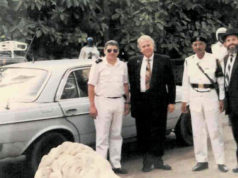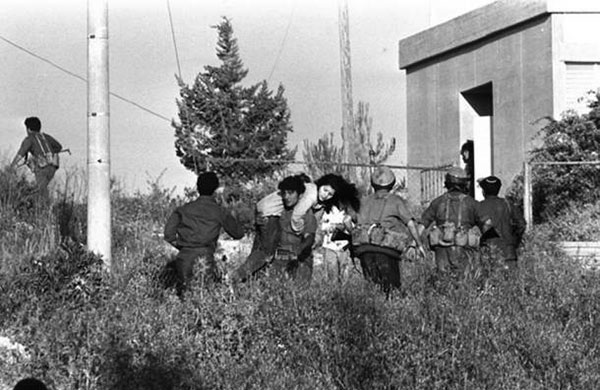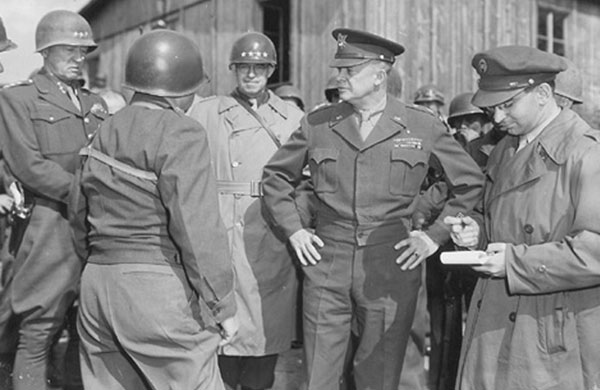 The story of how the US came to have the artifacts is incredible. Harold Rhode, an Arabic/Hebrew speaking policy analyst with the Office of Net Assessments in the Office of the Secretary of Defense, recently wrote a first person, eye-witness account of the details.
The story of how the US came to have the artifacts is incredible. Harold Rhode, an Arabic/Hebrew speaking policy analyst with the Office of Net Assessments in the Office of the Secretary of Defense, recently wrote a first person, eye-witness account of the details.
After American forces entered Baghdad in May 2003, the head of the Jewish and Israel section of Saddam Hussein’s Mukhabarat (intelligence agency) went to the Iraqi National Congress (INC), offering information about Saddam’s intelligence operations against Israel and Jews. He told them about rumored Jewish archives hidden in the basement of the Mukhabarat headquarters.
After his visit, INC chairman Ahmed Chalabi called Judy Miller, the former New York Times reporter then embedded with a mobile unit looking for WMD, and Harold Rhode. They rushed over to talk with Chalabi, who told them about the archives which included an ancient copy of the Talmud, written on leather or parchment. They then went to the Mukhabarat building with the informant and an INC contingent. The man who told them about the archives indicated from outside the building where in the basement the Jewish and Israel sections were located, then he promptly disappeared. Despite the bombed-out structure’s instability, looters were overrunning the building. Danger was everywhere.
They were standing beside a large metal device which had lodged itself halfway into the ground. They later learned that it was a live, undetonated bomb which had penetrated through three or four stories of the building and destroyed its water system. The bomb had pierced the wall almost at ground level, flooding the Jewish and Israel sections.
They went around to the building’s main entrance and descended halfway down a basement staircase, blocked by water. Several WMD team members waded into the water and entered the Israel section. They found the Jewish section, and carried out religious books and a tiq (the wooden/metal box which holds Torahs). These items proved to be only a tiny example of what they would find later.
Many Iraqis told them to get the material out of the country as soon as possible before what they were doing became public knowledge. That way no Iraqi politician could be held responsible for having let the Jews take the material. But that was not so simple. Almost all of the material was under water, and had to be rescued and salvaged. The team needed drainage pumps to get to the items, manpower to take the material out, and money to pay for both and had no access to either.
 Chalabi volunteered to start the project. His people procured pumps and hired locals to save the books, documents, and holy articles. They started draining at night and managed to get into the Jewish and Israel sections the next morning. But the water continued to drip down from the broken pipes, so by early afternoon it had risen too high and they were unable to continue their operation. This went on for the next few weeks.
Chalabi volunteered to start the project. His people procured pumps and hired locals to save the books, documents, and holy articles. They started draining at night and managed to get into the Jewish and Israel sections the next morning. But the water continued to drip down from the broken pipes, so by early afternoon it had risen too high and they were unable to continue their operation. This went on for the next few weeks.
They managed to secure a grant from philanthropist Harvey Krueger, an investment banker from Lehman Brothers, who heard about the project and managed to get them about $15,000 to continue the operation.
They tried to interest American officials in the Coalition Provisional Authority (CPA) but their pleas were not heard and the American bureaucracy was not helpful.
The next problem they faced was what to do with the material once they got it out of the building. Chalabi gave them 27 large aluminum trunks and space to dry out the materials. They were put in touch with Jerusalem’s Hebrew University document and book restoration section, whose director tried to give them instructions by phone on how to handle the material.
They dried the Torah and when the books and documents were still damp, put them in the large aluminum trunks. Day after day, they went down into the basement, rescued books, papers, and other materials and took it all two miles away where they dried it out. This process went on for about four weeks.
Every day, friends from around the world called to see how they were doing. Some deserve special mention because their intervention and assistance is the reason this material exists today. Natan Sharansky, the ex-Soviet dissident and Israeli government minister, heard about their predicament. He called Vice President Dick Cheney and asked if he could intervene with the American authorities in Iraq to save the materials. Richard Perle, the former assistant secretary of defense under Ronald Reagan called Donald Rumsfeld. Both Cheney and Rumsfeld then brought this matter up with the CPA, who, after previously refusing any assistance, went into action and took over the project.
Sharansky, Cheney, Perle, Rumsfeld, Ahmed Chalabi, and the members of the WMD team who originally waded into the water and discovered the material are the real heroes of the operation. It is largely due to their intervention that the Iraqi Jewish archive exists today. Without their help, it is unlikely that any of it would have survived.
As a result of their intervention, on June 5, 2003, the second day of Shavuot, the American authorities brought in large pumps which very quickly drained the entire area. The next day, the large amount of material still left in the archives was put in the rest of the aluminum trunks and then placed in a large refrigerated truck which kept the material as protected as possible until the American archival restorers arrived and took possession of the archive.
The materials were then flown to Texas where they were vacuum-freeze-dried, and in Fall 2003 they were brought to the National Archives. In 2011, the State Department kicked in over $3 million for stabilizing, digitizing, and packing the material.
Now, after exhibiting the archives, the US government has agreed to return it to Iraq. Mr. Rhode said, “It’s like returning artifacts to Germany, had they never renounced Nazism.”
The most logical final resting place for the material is the Babylonian Jewry Heritage Center outside of Tel Aviv. It is the only museum in the world dedicated to the history of Iraqi Jewry. If you would like to sign a petition to stop the archive from being given to Iraq, visit avaaz.org.



